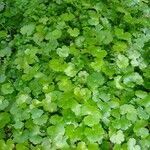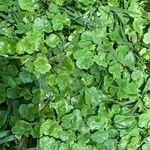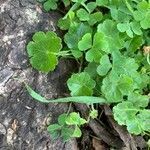Delicate slender creeping herb, rooting at the nodes. Stem filiform, whitish to brownish. Leaves on slender petioles of 3-40 mm long, glabrous or with scattered flexuous hairs near the tip, solitary or 2-3 together. Lamina reniform with a narrow basal sinus, crenately divided into 5-7 lobes, the margins of which have rounded triangular teeth. Superior leaf surface glabrous, the inferior usually with scattered crisped hairs particularly noticeable on young leaves. Inflorescence a simple subcapitate umbel, much shorter than the subtending leaf. Peduncle slender, 2-9 mm long. Umbel 3-8(10)-flowered, involucre of inconspicuous narrow lanceolate scarious bracts; rays minute to obsolete. Fruit 1.5 x 1.0 mm, greenish to yellowish-brown, broadly ellipsoid, laterally compressed; base broadly and shallowly cordate; apex deeply emarginate; stylopodium depressed to obsolete, styles short, stiff and divergent; ribs well developed.
Stems long-creeping or with ascendent extremities, sometimes almost caespitose, terete, thin or almost filiformous, glabrous or sparsely hairy. Stipules ½-1 by nearly 1½ mm, ovate to obovate, acute, entire or fringed. Petioles ½-6 cm, or even shorter in the uppermost leaves, more or less hairy; lamina ⅓-2½ cm through, roundish to 5-angular in outline, deeply cordate, 3-5-lobate to 3-5-partite; segments crenate to serrate, more or less pilose to hirsute. Inflorescences single along the creeping stems; peduncles 0-3 cm, filiformous, glabious or short hairy; involucres 4-10 around and between the flowers, nearly 1 by ½ mm, ovate, lanceolate, acute, base with 2 acute teeth, sometimes filiformous, lower ones reflexed in fruit. Pedicels 10-15; petals greenish white, nearly ¾ by ½ mm, ovate, acute. Mericarps 1-¼ by ¾ mm, yellow to brown, glabrous or with short stiff hairs, sometimes red-punctulate.
A small herb. It is slender and keeps growing from year to year. The stems are creeping and pressed close to the ground. Short aerial stems arise from the nodes. It grows 10 cm high and 30 cm across. The leaves are rounded to kidney-shaped and 3-6 mm across. They have shallow lobes. They leaves are smooth and without hairs. They are often shiny. The flowers are white or pale mauve and very small. They are in clusters of 3-7 and close to the stem.
Stems filiform, creeping; lvs subrotund, 1 cm wide or less, shallowly 7-lobed, on petioles 1–2 cm; peduncles surpassing the lvs; fls 3–10 per umbel; fr sessile, 1–1.5 mm wide, the ribs low and obscure; 2n=24. Native of trop. Asia, established in lawns from N.J. and Pa. to S.C., w. to Ind. and Ky. Apr.–Sept. (H. rotundifolia Roxb., not Wall.)
Perennial herb, hydrophyte, 0.1-0.3 m high. Leaves simple, blade kidney-shaped to almost circular, palmately cleft halfway down to base into 5-7 lobes, glabrous and shining above, scattered hairs beneath. Peduncles shorter than subtending petioles. Flowers in simple umbels. Flowering time mostly Nov-Jan.
Fruit 1·5 × 1·0 mm., greenish to yellowish-brown, broadly ellipsoid, laterally compressed; base broadly and shallowly cordate; apex deeply emarginate; stylopodium depressed to obsolete, styles short, stiff and divergent; ribs well developed.
Inflorescence a simple subcapitate umbel, much shorter than the subtending leaf. Peduncle slender, 2–9 mm. long. Umbel 3–8(10)-flowered, involucre of inconspicuous narrow lanceolate scarious bracts; rays minute to obsolete.
Lamina reniform with a narrow basal sinus, crenately divided into 5–7 lobes the margins of which have rounded triangular teeth.
Leaves on slender petioles of 3–40 mm. long, glabrous or with scattered flexuous hairs near the tip, solitary or 2–3 together.
Superior leaf surface glabrous, the inferior usually with scattered crisped hairs particularly noticeable on young leaves.
Delicate slender creeping herb, rooting at the nodes.
A small creeping herb, nearly glabrous
Stem filiform, whitish to brownish.




